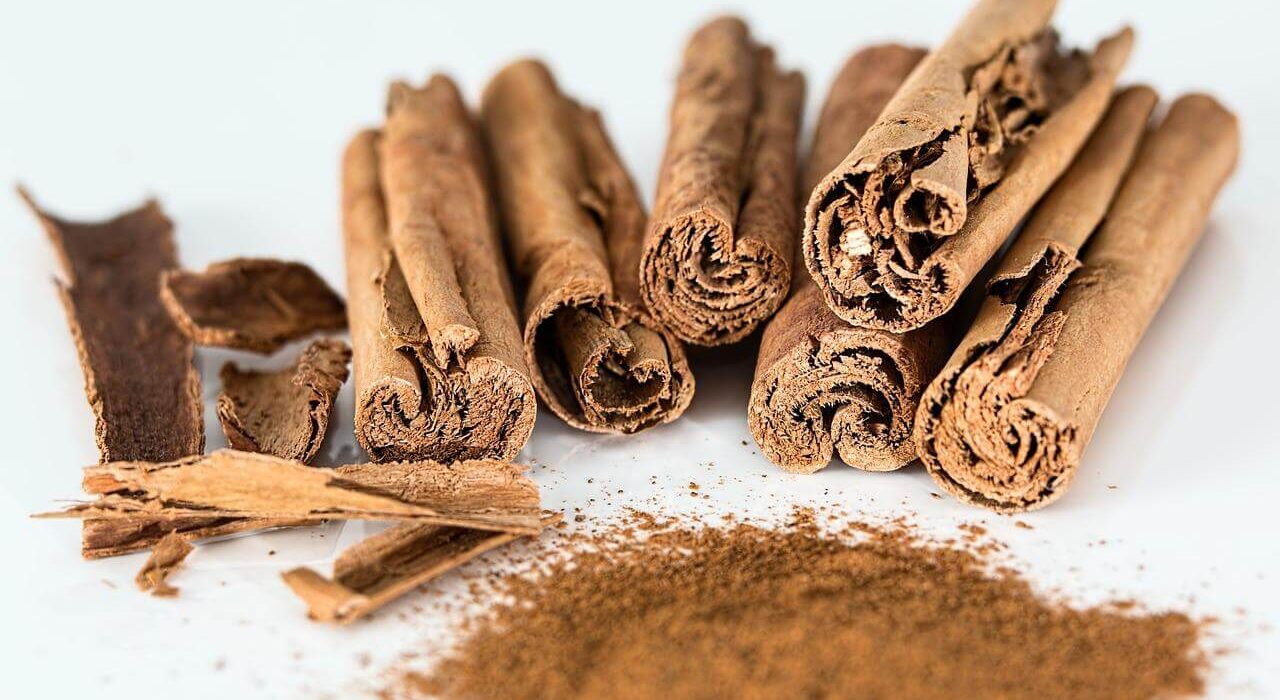I remember the first time I decided to bake a cinnamon rolls for my family. I had all the ingredients ready, or so I thought. As I reached for my trusty cinnamon shaker, I realized that I had run out! Desperate to complete my recipe, I rushed to the grocery store to pick up some more.

As I stood in front of the spice aisle, I was surprised by the variety of cinnamon available on the shelves. I picked up the first one I saw and headed home to finish baking my cinnamon rolls
When I finally took a bite of my freshly baked rolls, I noticed something was off. It had a slightly different taste and color that I couldn’t quite put my finger on. Although it still tasted good, I knew it wasn’t quite the same.

A few weeks later, I learned about the two main types of cinnamon – Ceylon cinnamon and cassia cinnamon. The cinnamon I had purchased at the grocery store was actually cassia cinnamon, which is commonly used in baking due to its stronger and more pungent flavor. However, Ceylon cinnamon, also known as “true cinnamon”, has a milder and sweeter taste profile.
Not only did I learn about the difference in taste, but I also discovered that Ceylon cinnamon is healthier than its cassia counterpart. It contains lower levels of coumarin, a compound that can cause liver damage in large doses.
From then on, I made sure to only buy genuine Ceylon cinnamon for my baking needs. And let me tell you, the difference in taste was noticeable! My cinnamon rolls were sweeter, more delicate, and had a beautiful light brown color.

That experience taught me the importance of paying attention to the ingredients I use in my cooking and baking. Even a small change, such as using a different type of cinnamon, can have a big impact on the final product.
What is Ceylon Cinnamon?
There are two main varieties of cinnamon, and they come from different plants.
The more common cinnamon, the kind that you eat that has been sprinkled on a donut or vanilla pudding, is made from the bark of an evergreen tree called cassia. This tree is found in countries like China and Indonesia.

Ceylon cinnamon, its scientific name being Cinnamomum verum, is derived from the bark of a small tree that is native to Sri Lanka. The cinnamon that comes from this tree is lighter than cassia cinnamon. Ceylon cinnamon, though not as widely used as cassia, is actually the “true” cinnamon.

What does Ceylon Cinnamon taste like?
Ceylon cinnamon has a sweet, delicate and complex flavor profile. It is milder than cassia cinnamon and has a subtle yet distinctive citrusy aroma. Ceylon cinnamon has hints of clove and nutmeg, as well as a slight spiciness, but it does not have the strong, pungent flavor of cassia cinnamon.

Overall, Ceylon cinnamon is sweeter, more refined and less overpowering than cassia cinnamon and it is often used in baking sweet treats, desserts, and beverages such as cinnamon rolls, apple pies, hot chocolate, and chai tea. Ceylon cinnamon is the one used in the bake shops all over Europe.
Its unique flavor and aroma can also enhance savory dishes like curries, stews, and sauces.
How to determine if you have Ceylon cinnamon or Cassia cinnamon
To determine if you have Ceylon cinnamon or cassia cinnamon, there are a few simple methods you can use:
- Look at the cinnamon stick: Ceylon cinnamon sticks are thin and papery, with a texture that resembles flaky layers of tissue paper. Cassia cinnamon sticks are thicker and harder, with a rougher texture that resembles tree bark.
- Smell the cinnamon: Ceylon cinnamon has a sweeter aroma that is highly fragrant and slightly citrusy. Cassia cinnamon has a stronger, more pungent aroma that is often described as spicy and warm.
- Taste the cinnamon: Ceylon cinnamon has a mild, slightly sweet taste with hints of citrus and clove. Cassia cinnamon has a stronger, spicier taste with a bitter aftertaste.

- Check the label: The packaging should indicate whether the cinnamon is Ceylon or cassia. If it doesn’t, look for clues such as the texture of the stick or the color of the powder. Ceylon cinnamon is typically lighter in color than cassia cinnamon.
By using these methods, you can easily distinguish between Ceylon cinnamon and cassia cinnamon and choose the right one for your cooking and baking needs.
Business Insider India will tell you why Ceylon cinnamon is so expensive:
Which cinnamon is the healthiest?
Ceylon cinnamon is the winner in the health category. Cinnamon is known to have a natural component that acts as a blood thinner called coumarin.
Coumarin is found in much higher concentrations in cassia cinnamon, and when consumed in higher amounts, this could be detrimental or toxic to some.
Even though coumarin is found in nature, it has the potential to cause liver damage in those with sensitivities and among those who consume the cassia variety daily.
According to the Paleo Foundation, Cassia cinnamon has much higher levels of coumarin, about 0.4-.8%. This is important to consider if someone is on hepatotoxic medications or preparing for surgery or dental work due to the thinned state of the blood after eating cassia cinnamon.
In contrast, Ceylon cinnamon contains much less coumarin, .03%-.04%. This is why in some European countries, Ceylon cinnamon is the only one available.
Health benefits of Ceylon Cinnamon
Diabetic Medicine published an article that looked at 16 different studies on Ceylon cinnamon. They uncovered the fact that cinnamon is good for diabetics, but cassia cinnamon can be toxic to the liver due to it is higher concentration of coumarin.

Ceylon cinnamon is beneficial to diabetics without any toxicity being delivered to the liver and kidneys.
This is just one of many benefits of Ceylon cinnamon. According to the Cleveland Clinic, it also:
- Is high in antioxidants
- Protects against cancers and heart disease
- Strengthens tiny blood vessels called capillaries
- Antimicrobial

- Anti-parasitic
- Reduced blood pressure
- Aids in digestive health
- Rich in manganese which help produce bone repair hormones
What are some quality brands of Ceylon cinnamon to try?
2 Highly Rated Ceylon Cinnamon Stick Brands
1. Viva Doria Organic Ceylon Cinnamon Sticks
Viva Doris Ceylon Cinnamon Sticks are occasionally on sale on Amazon.
Why we love Viva Doria Ceylon Cinnamon Sticks:
- Certified Organic
- Raw from Sri Lanka
- Sourced from the highest quality Ceylon cinnamon available
- Highly rated on Amazon at over 220 ratings at 4.5 stars
- 1 pound bag, About 75 sticks
2. Ceylon Flavors Organic Ceylon cinnamon sticks
Ceylon Flavors Cinnamon Sticks are occasionally on sale at Amazon.
What we love about Ceylon Flavors Cinnamon Sticks:
- Delicate, sweet flavor
- Small, 1 oz size of 6-7 sticks
- Certified Organic
- From Sri Lanka
- Best Seller on Amazon with over 4600 ratings at 4.5 stars
Why use cinnamon sticks over powdered cinnamon?
Use cinnamon sticks when you want to add flavor and depth to a savory or sweet recipe, while also being able to remove them after a certain amount of time when the desired flavor is achieved. With powdered cinnamon, this option and experimentation is not as easy.
Do cinnamon sticks dissolve?
Cinnamon sticks do not dissolve completely, even after being processed into a powder. This is because they come from tree bark, so they are too fibrous to dissolve, but they will disintegrate somewhat, depending on the length of cooking time, and release flavor as they do.
5 ways to use cinnamon sticks
- Put a cinnamon stick in your coffee for a leveled-up taste.
- Flavor oatmeal by adding a cinnamon stick to the pot when cooking.
- Add a stick to the slow cooker when making a roast for another level of spice.
- Put a cinnamon stick in hot water for a soothing cup of Cinnamon Tisane.

- Use as a drink stir
Concluding thoughts on Ceylon cinnamon sticks
Ceylon cinnamon sticks are a versatile and flavorful addition to any kitchen. Whether you’re using them in sweet or savory dishes, these high-quality cinnamon sticks can add a unique and delicious twist to your favorite recipes.
And with five great ways to use them – from brewing tea to seasoning meats – you’ll never run out of ways to enjoy this fragrant and flavorful spice. So why not spice up your cooking with some Ceylon cinnamon sticks today? Your taste buds will thank you!
More from thewellthieone.com
Additional Sources
- “Ceylon Cinnamon: Health Benefits, Uses, and More” by Healthline – https://www.healthline.com/health/food-nutrition/ceylon-cinnamon-benefits-uses
- “What Is Ceylon Cinnamon and Does It Have Health Benefits?” by Verywell Health – https://www.verywellhealth.com/what-is-ceylon-cinnamon-89069
- “Ceylon vs Cassia – Not All Cinnamon Is Created Equal!” by Dr. Axe – https://draxe.com/nutrition/ceylon-cinnamon/
The links used on thewellthieone.com are affiliate links, which may provide a small commission. This does not increase the price of the goods for the consumer whatsoever. What it does is ensure that useful content like this can continue to be produced. Thank-you for enjoying our content and allowing us to continue to provide more.




